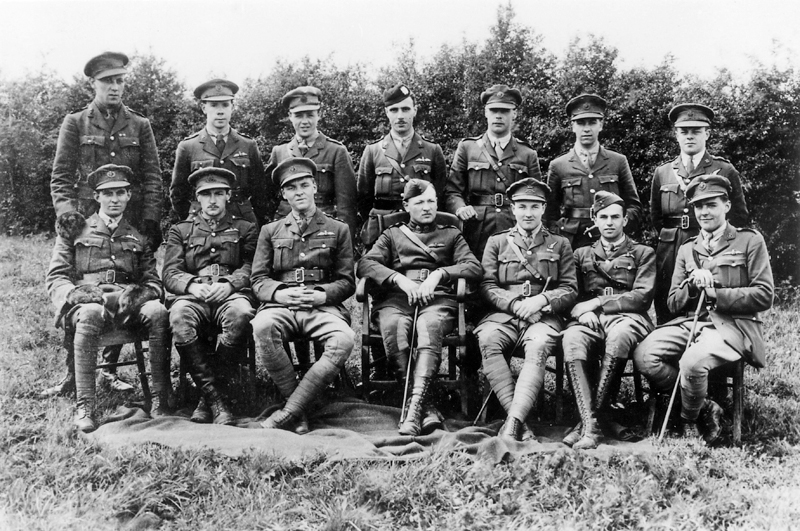
My Father, Reginald Vaughan Facey, was a pilot in the Royal Flying Corps towards the end of World War I, in number 7 squadron. His observer was 'Peter' A G Wilson. They both went on to read medicine at Brasenose College, Oxford and became GPs. Peter Wilson kept a diary which I quote from below.

Front row, second from the right Reginald Vaughan Facey, third from right 'Peter' A G Wilson. On the left of the front row Wilfred George Allanson; back row, third from the left, is 2nd Lieut. W. R. Gray. Front row, second from left, is William H. King, and behind him in the back row we think is Harold Hughes (my thanks to Peter Rowbottom for these identifications). King and Hughes were killed in April 1918 (see below). Back row, third from the right may be observer Lt. E. R. Manley (my thanks to Kurt Hughes for suggesting this). I cannot identify the others, although some of their signatures may be below. (I had always assumed that the man in the centre of the front row was 'Bertie' Sutton, the commanding officer of No. 7 Squadron. He later became Air Marshal Sir Bertine Entwisle Sutton but there aren't any good photos of him on the internet. Or rather, there weren't until a Belgian, Jean-Luc Michel, sent me this one. From these two photos, I think that Sutton isn't present in the above picture, so that man is probably the C.O. of 'B' flight whose name I do not know.)
Some time in 1917, when he was 18 years old, my father went to train as a pilot in the RFC.
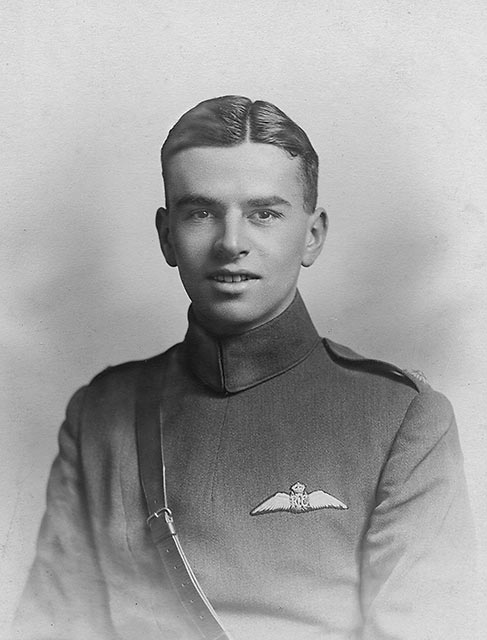
Below is my father's pilots licence—
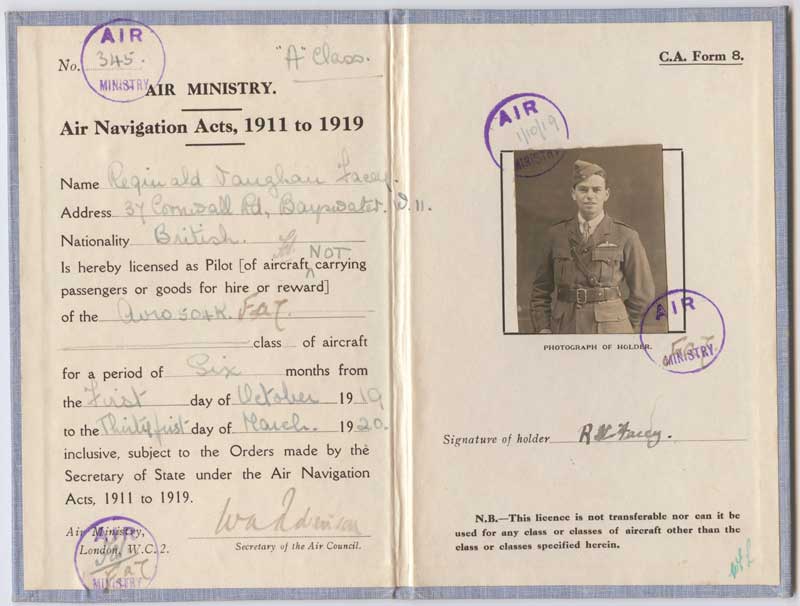
It seems the Air Ministry used civilian licence documents with the insertion of the word NOT. The licence is for "the Avro 504K class of aircraft".
Training was rudimentary. My father had been taught to land by being told to fly gently downwards until he could see the individual blades of grass and then pull up a bit. Unfortunately, my father had rather poor eyesight and never could see the blades. As a result, he gained a reputation for writing off his undercarriage. Diary entries—
21st November 1917 "Facey makes a flight but creases an undercarriage".
28th November 1917 "Facey appears to have a strong liking for hop poles"
22nd December 1917 "Facey adds to his list of broken undercarriages"
6th January 1918 "Facey finds the aerodrome very hard and his practice of demonstrating faulty rigging of undercarriage ably demonstrated!"
3rd February 1918 "Facey has forced landing near Vlamatynge. Very near shave."
16th March 1918 "Up early with Facey and we drop two bombs and chase some wild duck over the flooded areas. Facey still causing much consternation to the riggers of 'B' flight as he insists that the undercarriage is so poorly constructed!"
17th June 1918 "After lunch up again with Facey on Obliques, but engine dud so we return. Throttle sticks so Facey lands by switch, but alas on final flight he crashes undercarriage. The first for three months!"
He told me that, despite this, he had no problem getting observers to fly with him as he was fine when airborne. See copies of my father's accident reports.
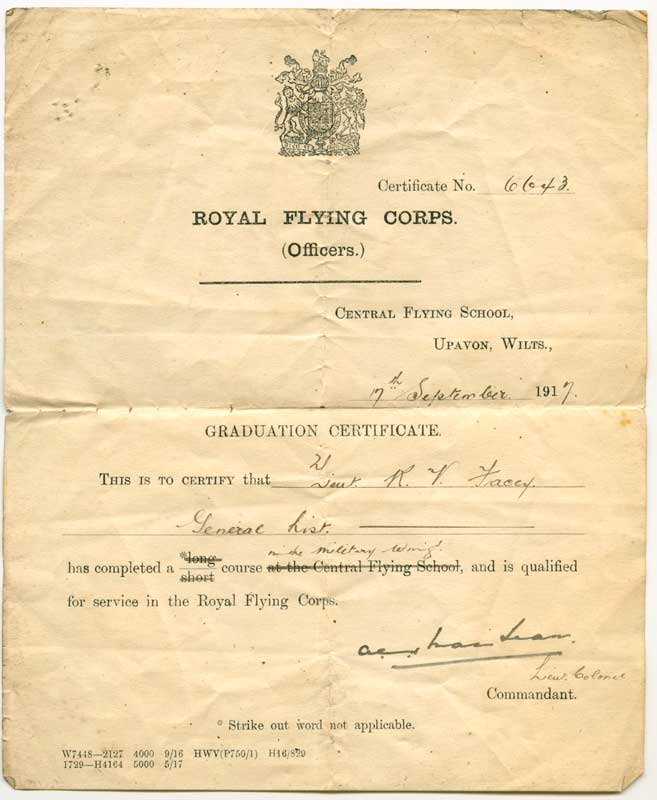
It seems that training was insufficient for the job, and unless new pilots were lucky enough to survive the first few missions, and thus gain some combat experience, they were sunk. Diary entries—
4th January 1918 "New pilot killed in crash"
30th March 1918 "New pilot killed in crash"
12th April 1918 "Flying with Harland. We spot Glenny in his machine and then suddenly see him nose dive, appears strongly as if hit. Bosche pepper our machine. In communication by lamp with Worcesters. Amazing sight to witness French evacuation of Armentieres. We return to Proven and just before landing see a landing R.E.8 blow up, as bombs explode on machine landing. King and Hughes killed as result. Only machine to return of initial 6."
5th June 1918 "Fletcher performs amazing stunt by attempting to destroy most of the Squadron's machines whilst 'taking off'; he crashes into at least 4 machines and plays havoc with the rigging. Startled mechanics flee for shelter behind lorries and hangars."
6th June 1918 "Fletcher and Darneley journey to Czerney to collect two new machines to replace some of yesterday's wreckage. On flying them back to aerodrome they get caught in severe storm, lose their way and crash, destroying both machines."
Flying in the first World War was exceptionally hazardous. At its low point, in 1917, the average life expectancy of a pilot was 21 days (risks considerably higher than those faced by Bomber Command in WWII). My father qualified as a pilot in the RFC in October 1917 at the age of nineteen, so he only caught the tail end of the war and that was fortunate otherwise I probably wouldn't be here. It seems that the airmen spent much of their spare time drinking, which is perhaps understandable.
Here is one of the reconnaissance photos taken, I presume, by Peter Wilson whilst my father was flying the plane:
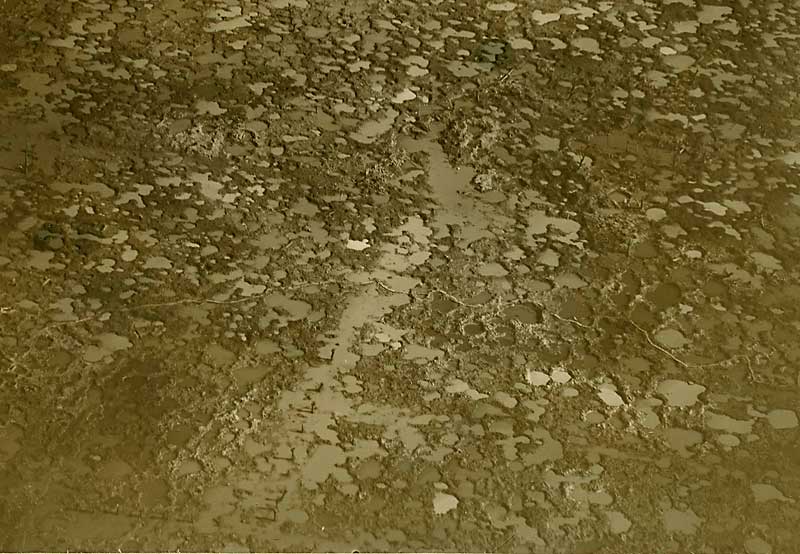
I think the pale streaks are duck boards. As this was the only photo my father kept, it can be deduced that the density of shell holes seen here was exceptional. If you looked at this from ground level it might have appeared somewhat as shown in the photo by Frank Hurley here.
Here is a map which my father kept. It shows Ypres at the bottom left corner, and the squares are 1 Km x 1 Km. He told me that he had this folded in his lap as he was flying the plane, and they were machine gunned by a German fighter from the rear. One of the bullets clipped my father's shoulder, removing the button there and sending its fragments through the map.
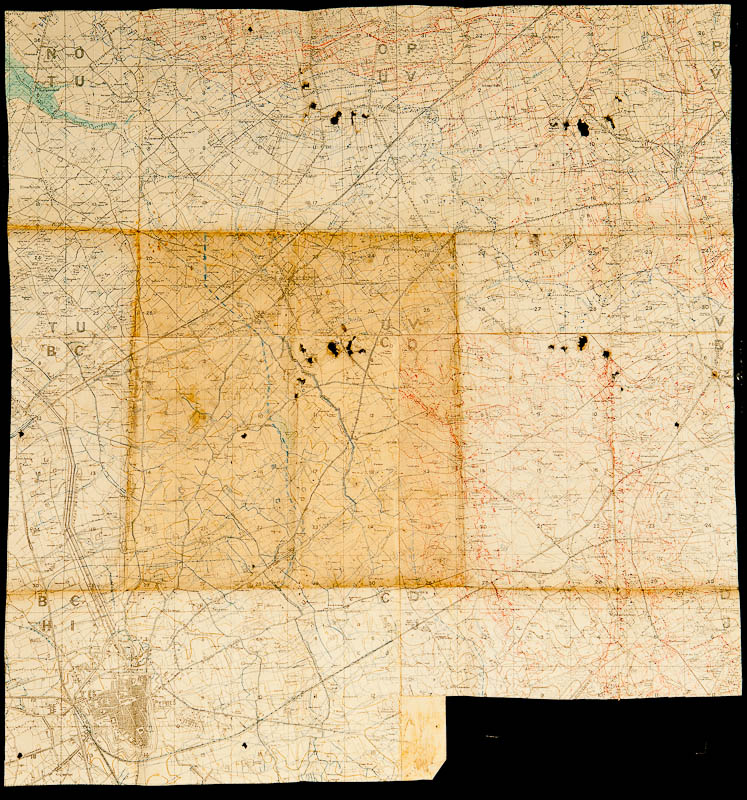
The postcard below was sent to my father in London and is postmarked 27 June 1918. It is marked CARTE POSTALE but seems to have been posted in Britain. Presumably there was some service in Belgium for turning one's own photo into a postcard, which was then brought back.
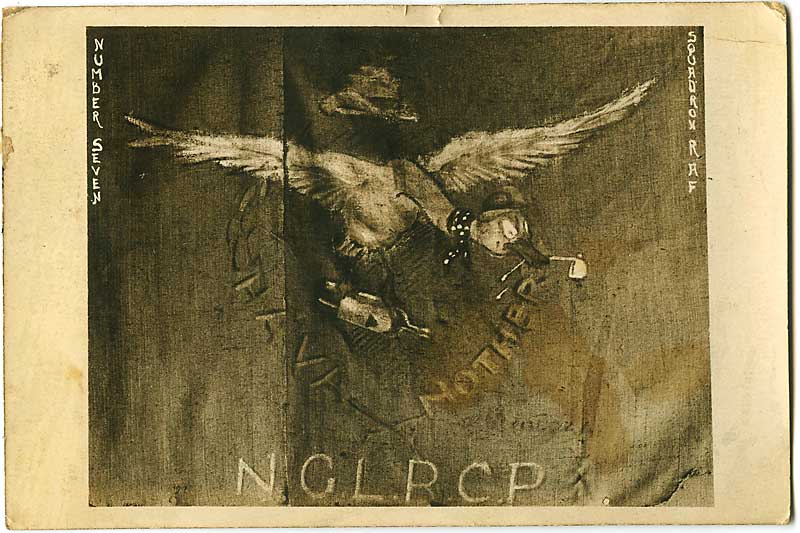
It is a photo of the squadron's unofficial coat of arms, with its motto HAVA NOTHER. Peter Wilson's diary (see below) entry for January 31st 1918 includes "Austrian prisoners decorate the Mess, and one produces clever cartoon painting on canvas entitled 'Hava Nother'." I don't know what the letters NGLRCP stand for, but the diary entry for December 19th 1917 includes "Flight with Wattie, but N.G.L.R.C.P." (NG probably stands for "no good" since I found the following other entry in the diary "Dud day, but some silly blighter of No. 21 Sqdn. insists on sending O.K.L.R.C.P."). I asked the RAF Museum if they knew what these abbreviations stand for and received the following reply from Andrew Dennis, Assistant Curator: "I have not found any reference to the abbreviations used on the item you have, working on your theory that OK equates to OK and NG to no good, I speculate that CP is Contact Patrol and LR is Line Reconnaissance. These being common operations flown by RFC/RAF squadrons in the First World War, a contact patrol would be conducted by fighter aircraft in order to make contact with enemy aircraft and line reconnaissance is as it sounds, reconnaissance aircraft reconnoitring the front line. Thus I suspect that the acronym reads OK or No Good for Contact Patrols and/or Line Reconnaissance."
Peter Wilson kept a diary of his war time experiences from November 1917 to July 1918, and after the war it was published privately by the committee set up to keep the old members of the squadron in touch. The secretary, Mr. E. W. Fletcher, wrote in his forward that "the committee were of the opinion that amplification of certain events would be desirable, and a drastic censorship of others an urgent necessity". The slim volume was subsequently privately published in 1928 with Peter Wilson's approval, just before No. 7 Squadron's tenth annual memorial dinner. A copy of the diary is in the Imperial War Museum here.
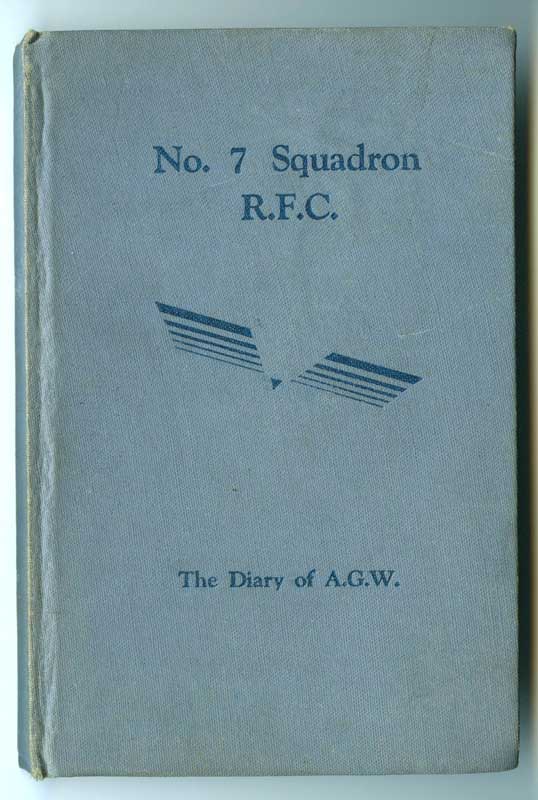
The inside back cover of my father's copy is signed by various members of the flight:
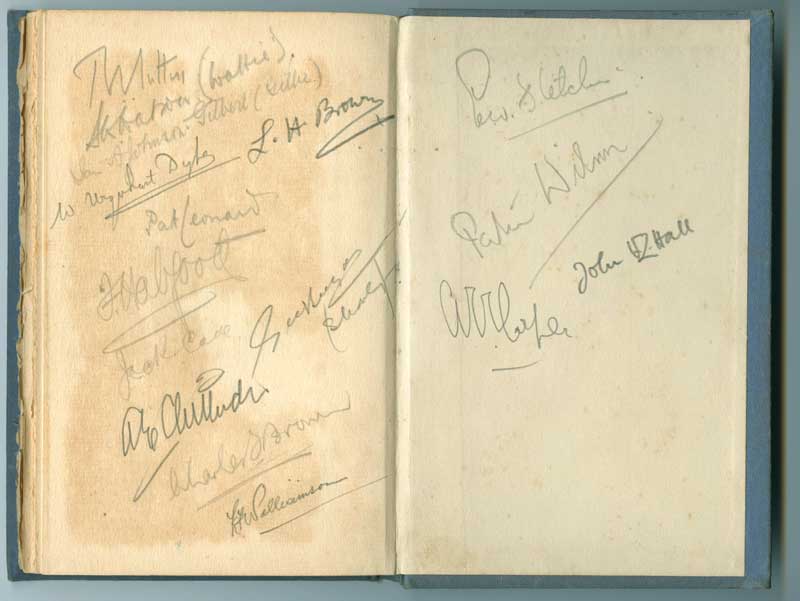
I can decipher L. H. Brown, Pat Leonard, F. Habgood, E. W. Fletcher, L. F. Williamson, John Hall, W. Urquhart Dykes (see here), Sam A. Johnson? Gilbert (Gillie), C. W. Cooper and Peter Wilson. Also the signature of Watson? known as 'Wattie'.
In February 2017 I was emailed by Jim Hutchinson who said that his grandfather, 2 Lt James Gillespie Clayton, flew with 7 Sqn in 1918. He joined the squadron as an observer in August and was wounded in combat on 5 Oct along with his pilot, Leslie Horsewell Brown who must be the LH Brown whose signature appears above.
The diary also contains an article written by the C.O., by then Wing Commander, Sutton on The work of a Corps squadron. Regarding artillery observation work, he notes "Perhaps the fact that it is the pilot who observes is worth mentioning. The observer is a machine gunner. It is easier for the pilot who controls the machine to be in a position to see the bursts, and he can, without thought, send his signals when the machine is in the right direction for Morse-sending." The idea that a pilot flying a plane can, "without thought", simultaneously operate a Morse key is quite surprising to me. It was the observer who operated the camera when needed.
I find it interesting that in the diary, and even in the 1928 article, they were still referring to 'machines' rather than to aeroplanes. The fact that the plane had to be flying in the right direction before sending Morse signals suggests that they were using a horizontally-mounted dipole aerial (such aerials transmit most effectively at rightangles to their line).
Peter Wilson's diary also contains a section on the movements of No. 7 Squadron, from which I have abstracted the following—
| Date | Place | C.O. | Aeroplanes |
|---|---|---|---|
| May 1914 | Formed at South Farnborough | ||
| October 1914 | Netheravon | Capt. A. G. Board | |
| April 1915 | St. Omer, France | Maj. C. G. Hoare | RE5s, Vickers, Voisins |
| September 1915 | Droglandt, France | Capt. A. G. Board | |
| December 1915 | Bailleul, France | Maj. F. J. L. Cogan | |
| July 1916 | Warloy, France | Maj. R. M. Vaughan | |
| February 1917 | Moreuil (near Amiens) | Maj. A. T. Whitelock | |
| May 1917 | Proven E., Belgium | Maj. R. M. Vaughan | |
| June 1917 | Proven E., Belgium | Maj. R. M. Vaughan | RE8s |
| October 1917 | Proven E., Belgium | Capt. B. E. Sutton | RE8s |
| April 1918 | Droglandt, France | Capt. B. E. Sutton | RE8s |
| September 1918 | Proven E., Belgium | Capt. B. E. Sutton | RE8s |
| October 1918 | Bisseghem, Belgium | Capt. B. E. Sutton | RE8s |
| 1 November 1918 | Staceghem, Belgium | Capt. B. E. Sutton | RE8s |
| 5 November 1918 | Menin, Belgium | Capt. B. E. Sutton | RE8s |
| 15 November 1918 | Staceghem, Belgium | Capt. B. E. Sutton | RE8s |
| 27 November 1918 | Cognelée, Belgium | Capt. B. E. Sutton | RE8s |
| 8 December 1918 | Elsenborn Camp, Belgium | Capt. B. E. Sutton | RE8s |
| 14 December 1918 | Bickendorf, Germany† | Capt. B. E. Sutton | RE8s |
| 20 December 1918 | Spich, Germany† | Capt. B. E. Sutton | RE8s |
| 31 December 1918 | Spich, Germany† | Maj. R. E. Saul | RE8s |
| June 1919 | Buckheim, Germany† | Maj. R. E. Saul | RE8s |
| August 1919 | Heumar, Germany† | Maj. R. E. Saul | RE8s |
| 10 September 1919 | to England | Maj. R. E. Saul | RE8s |
| 31 December 1919 | Discharged at Eastleigh | RE8s |
† These locations are in the German state of North Rhine-Westphalia, within about 20 miles of Cologne. My thanks to George A. Fuller (son of George S. B. Fuller, who served in No. 9 Squadron at Proven from 10th September 1917 to 9th March 1918) for this information.
The American surgeon Harvey Cushing mentions No. 7 Squadron in his memoirs in the item for October 29th here (thanks to Gerry Deignan for this link).
David Seymour tells me that his grandfather, Corporal David James Searle, was in 7 Squadron RFC from 1915-1919 as the squadron motorcyclist.
In December 2015 I was contacted by Bart Vandamme, President of the Flanders Aviation Society which has a museum at Bisseghem in Belgium, asking if he could use some of the material on this web site for a special exhibition they were mounting to mark the 100th anniversary of that airfield. He kindly sent me this photo of no. 7 Squadron RAF at Bisseghem in 1995.
This web site airhistory is an incredibly useful resource for anyone researching the RFC.
| 5 July 1917 | General List (RFC) - Cadets to be temporary 2nd Lieuts. (on probation)† |
| 17 September 1917 | Graduated from Central Flying School, Upavon, Wilts |
| 11 October 1917 | Appointed as Flying Officer† |
| 8 March 1918 | "Facey goes on Counter Battery photos for first time."* |
| July 1918 | "[Wilson] At Reading lecturing on Artillery Observation. Facey at No. 143 Sqdn."* |
| 28 February 1919 | Transferred to the unemployed list - Feb 5th† |
† My thanks to Joost Muller for finding copies of the London Gazette which were reproduced in Flight Magazine at the time, and can be seen here for example.
* From Peter Wilson's diary.
After the war my father went on a trip to the USA with his friend Ralph G. Crimmins of Boston, an American he had met at Oxford. They sailed on Cunard's RMS Mauretania in June 1920. It seems that Crimmins father, Mr. T. A. Crimmins, must have been connected to the American political establishment because whilst in the Atlantic my father received the following telegram from the American President Woodrow Wilson:-
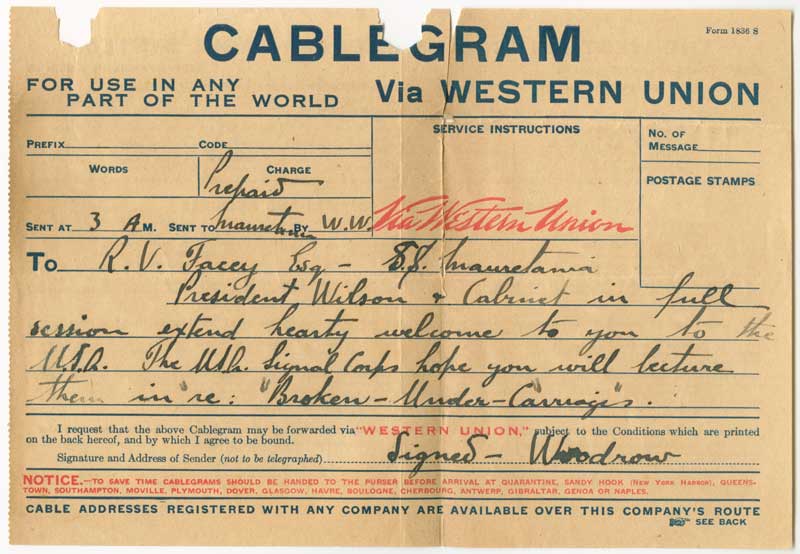
To R. V. Facey Esq – S.S. Mauretania
President Wilson & Cabinet in full session extend hearty welcome to you to the U.S.A. The U.S.A. Signal Corps hope you will lecture them in re. "Broken under carriages".
My father was not a "flying ace" but it seems he became a minor celebrity in the US and was invited to a fair few functions. The cutting below incorrectly reports his name as "Lieut. Reginald VonFacey", the reporter possibly having been led astray by the German ace Baron Manfred von Richthofen.
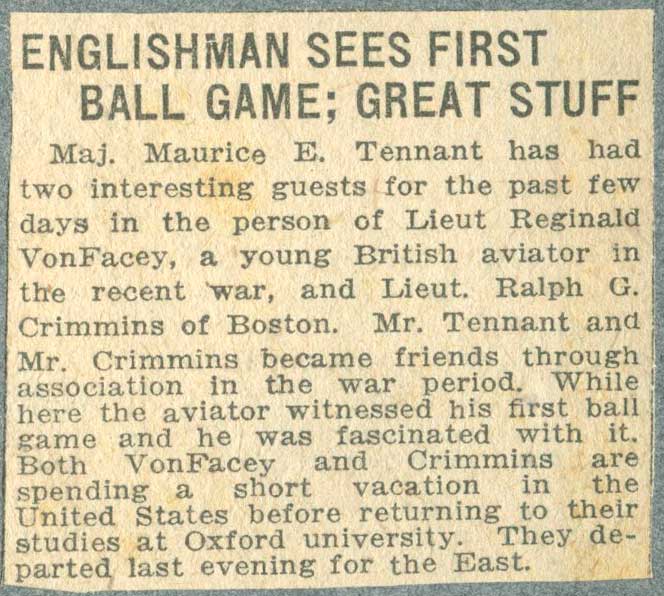
My father died in June 1971 at the age of 72. Peter Wilson died in April 1990 at the age of 95 and his obituary may be found in the British Medical Journal volume 300 issue 6737 (unfortunately one of those sites that charge you money).
Peter Facey, Winchester, England
20200503 Possible identification of Lt. E. R. Manley added
20190922 Page added about Leslie Horsewell Brown and James Gillespie Clayton
20180113 King and Hughes identified in photo
20170219 2 Lt James Gillespie Clayton added
20160715 Accident reports added
20160120 Photo of No.7 Squadron in 1995 added
20150209 Info about W. R. Gray added
20140809 Photo of Bertie Sutton added
20140502 Corporal Searle added
20140228 NGLRCP meaning added
20140108 Cognelée link added
20130926 Wilfred Allanson added
20130421 link added
20121222 corrected reference to 'Bertie' Sutton
20120926 more
20111204 originated